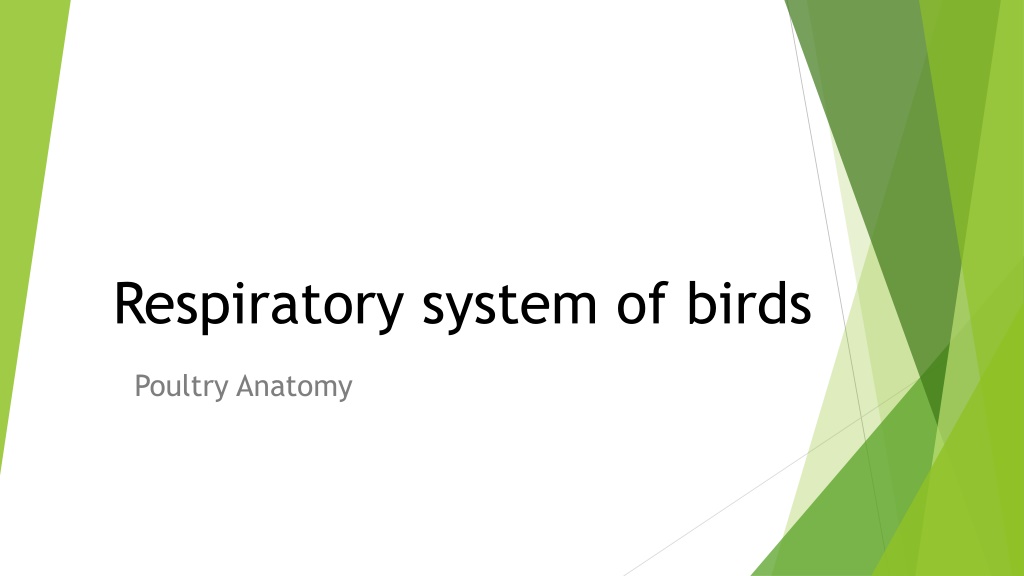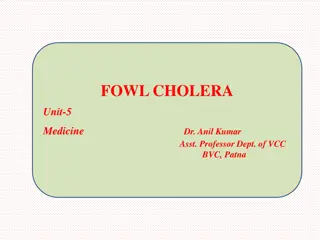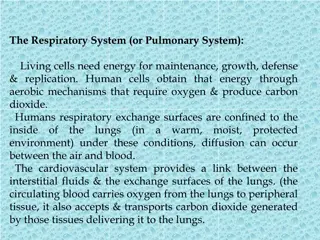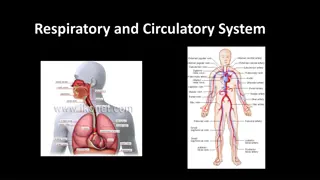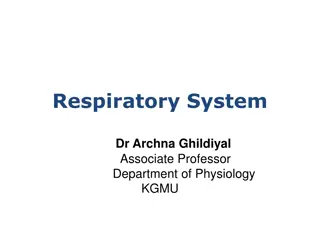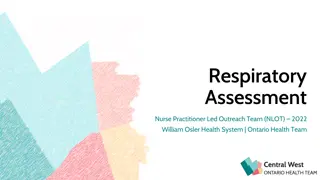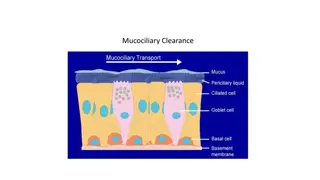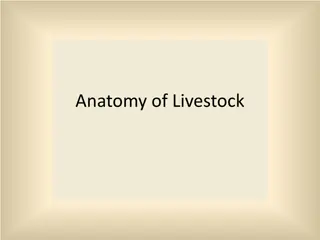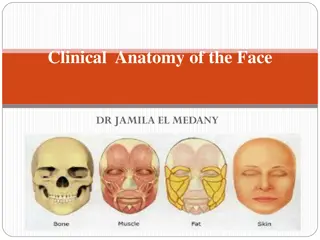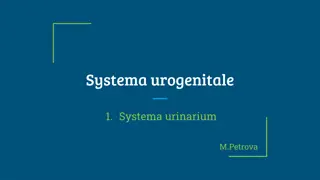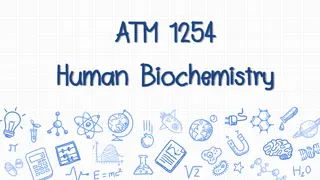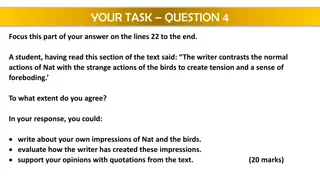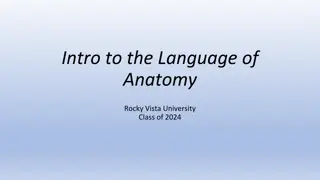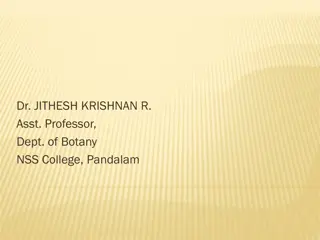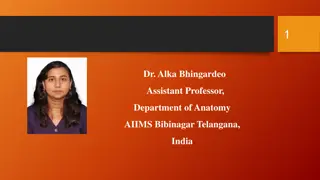Anatomy of the Respiratory System in Birds: A Detailed Overview
The respiratory system in birds, including poultry, consists of various components such as nostrils, nasal cavities, larynx, trachea, syrinx, air sacs, and lungs. Each part plays a crucial role in respiration, with unique features adapted to avian physiology. Understanding the anatomy of the avian respiratory system is essential for bird health and husbandry practices.
Download Presentation

Please find below an Image/Link to download the presentation.
The content on the website is provided AS IS for your information and personal use only. It may not be sold, licensed, or shared on other websites without obtaining consent from the author. Download presentation by click this link. If you encounter any issues during the download, it is possible that the publisher has removed the file from their server.
E N D
Presentation Transcript
Respiratory system of birds Poultry Anatomy
Respiratory System of birds The respiratory system in the birds composed of :- A- Nostrils. B- Nasal cavity. C- Larynx. D-Trachea. E- Syrinx. F- Air sac. G- Lungs ( two lung ).
A- Nostrils (nares): Located at the base of the beak surrounded by a thick cere as in psittacines which lead into nasal cavity. B- Nasal cavities: Nasal cavities are laterally compressed and extend to large orbits , rostral, middle and caudal conchae that arise from the lateral wall encroach on space. They play a major role in olfaction, filtering and the thermoregulation.
C- Larynx: The larynx occupies a mound on the floor of oro-pharynx. It is supported by cricoid and paired arytenoid cartilages that differ markedly from their mammalian counterparts but occupy similar positions. The glottis formed by the arytenoid , closes the entrances to the larynx by reflex muscular action, preventing food particles and other foreign matter from reaching the lower air passages. The voice production occur in the syrinx , specialization at the tracheal bifurcation.
D- Trachea: Trachea composed of the tightly stacked , complete and overlapping cartilaginous rings, accompanies the esophagus through the neck , it can be palpated on the right side. The trachea into left and right tubes, making it very easy to intubate a primary bronchus by mistake. E- Syrinx: The syrinx is formed by terminal part of the trachea and first parts of primary bronchi. The trachea cartilages of syrinx are sturdy , but the bronchial cartilages are largely lacking, although a short vertical bar separates the bronchial openings.
F- Lungs: The lungs are relatively small, unlobed, bright pink and nonexpansile, although somewhat firmer then mammalian lungs because they contain far more cartilage, the lungs of birds are soft and velvety to the touch. The two surfaces of lungs, the convex dorsal surface is shaped to the curvature of the ribs; the concave ventral surface lies against the horizontal septum and faces the esophagus, heart and liver. The primary bronchus enters the ventral surface, passes diagonally through the lung (as mesobronchus), narrowing as it goes and at the caudal border becomes continuous with the abdominal air sac. In chicken it gives off 40 to 50 secondary bronchi classified as medioventral, mediodorsal, lateroventral and laterodorsal according to the general areas of lung they supply. These groups of secondary bronchi have various connection with air sac. These communications are essential to the passage of air through the lungs.
Lungs The secondary bronchi give off 400-500 parabronchi in whose relatively thick wall are contained the sites. Where gas exchange takes place the parabronchi lumen give rise the air capillaries. Gas exchange takes place across the barrier which present in capillaries, the air capillaries are therefore comparable with the alveoli mammalian lung. The essential differences is that the air capillaries are not terminations of the respiratory tree but continuous channels that can receive oxygen rich air from either direction.
G- Air sacs: Air sacs are blind, thin-walled (two cell thick) enlargements of bronchial system that extend beyond the lung in close relationship to the thoracic and abdominal viscera. Diverticular from some sacs enter various bones and even reach between muscles. The chicken has eight air sacs : single cervical, clavicular, paired cranial thoracic, caudal thoracic, abdominal sacs.
The chicken has eight air sacs 1) cervical sac consist of small central chamber ventral to the lungs. 2) larger clavicular sac lies in the thoracic inlet its thoracic part filled the space cranial to and round the heart and extend into sternum. 3) paired cranial thoracic sacs lies ventral to lungs between the sternal ribs and the heart and liver. 4) paired caudal thoracic sacs lie more caudally between the body wall and abdominal sacs. 5) paired abdominal sacs are largest. They occupy the caudodorsal parts of abdominal cavity where they are in broad contact with the intestines, gizzard, genital organs and kidneys and the acetabulum.
Most birds have 9 air sacs one interclavicular sac two cervical sacs two anterior thoracic sacs two posterior thoracic sacs two abdominal sacs Functionally, these 9 air sacs can be divided into anterior sacs (interclavicular, cervicals, & anterior thoracics) & posterior sacs (posterior thoracics & abdominals). Air sacs have very thin walls with few blood vessels. So, they do not play a direct role in gas exchange. Rather, they act as a 'bellows' to ventilate the lungs
Avian Respiration The avian respiratory system delivers oxygen from the air to the tissues and also removes carbon dioxide. In addition, the respiratory system plays an important role in thermoregulation (maintaining normal body temperature). The avian respiratory system is different from that of other vertebrates, with birds having relatively small lungs plus nine air sacs that play an important role in respiration (but are not directly involved in the exchange of gases).
Bird Respiratory System: How it Works Respiration in birds is much different than in mammals. Birds have a larynx, but it is not used to make sounds. Instead, an organ termed the "syrinx" serves as the "voice box." Birds have lungs, but they also have air sacs. Depending upon the species, the bird has seven or nine air sacs. Air sacs do not play a direct role in oxygen and carbon dioxode exchange, however they do keep oxygen rich air moving, in one direction, through the avian respiratory system. The air sacs of birds extend into the humerus (the bone between the shoulder and elbow), the femur (the thigh bone), the vertebrae and even the skull.
Bird Respiratory System: How it Works Birds do not have a diaphragm; instead, air is moved in and out of the respiratory system through pressure changes in the air sacs. Muscles in the chest cause the sternum to be pushed outward. This creates a negative pressure in the air sacs, causing air to enter the respiratory system. Expiration is not passive, but requires certain muscles to contract to increase the pressure on the air sacs and push the air out. Because the sternum must move during respiration, it is essential that it is allowed to move freely when a bird is being restrained. Holding a bird "too tight" can easily cause the bird to suffocate. Because birds have air sacs that reach into the bones, and have no diaphragm, respiratory infections can spread to the abdominal cavity and bones.
Bird Respiratory System: How it Works Bird lungs do not expand or contract like the lungs of mammals. In mammalian lungs, the exchange of oxygen and carbon dioxide occurs in microscopic sacs in the lungs, called 'alveoli.' In the avian lung, the gas exchange occurs in the walls of microscopic tubules, called 'air capillaries. The respiratory system of birds is more efficient than that of mammals, transferring more oxygen with each breath. This also means that toxins in the air are also transferred more efficiently.
Bird Respiratory System: How it Works This is one of the reasons why fumes from Teflon are toxic to birds, but not to mammals at the same concentration. When comparing birds and mammals of similar weight, birds have a slower respiratory rate. Respiration in birds requires two respiratory cycles (inspiration, expiration, inspiration, expiration) to move the air through the entire respiratory system. In mammals, only one respiratory cycle is necessary.
Respiratory Cycle of a Bird 1. During the first inspiration, the air travels through the nostrils, also called nares, of a bird, which are located at the junction between the top of the upper beak and the head. The fleshy tissue that surrounds them, in some birds, is called the cere. As in mammals, air moves through the nostrils into the nasal cavity. From there it passes through the larynx and into the trachea. Air moves through the trachea to the syrinx, which is located at the point just before the trachea divides in two. It passes through the syrinx and then the air stream is divided in two as the trachea divides. The air does not go directly to the lung, but instead travels to the caudal (posterior) air sacs. A small amount of air will pass through the caudal air sacs to the lung.
Respiratory Cycle of a Bird 2. During the first expiration, the air is moved from the posterior air sacs through the ventrobronchi and dorsobronchi into the lungs. The bronchi continue to divide into smaller diameter air capillaries. Blood capillaries flow through the air capillaries and this is where the oxygen and carbon dioxide are exchanged. 3. When the bird inspires the second time, the air moves to the cranial air sacs. 4. On the second expiration, the air moves out of the cranial air sacs, through the syrinx into the trachea, through the larynx, and finally through the nasal cavity and out of the nostrils.
